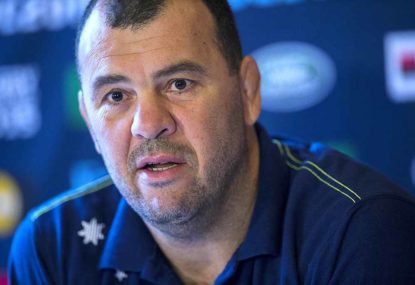While I am an ardent supporter of Wallaby coach Michael Cheika and of his motivational methods I have previously compared his Waratahs and Wallabies to that of a ‘brawler’.
They are full of spit and vinegar, rough round the edges, not asking for or giving a quarter. This approach has had its successes no doubt, yet it remains fact that when a ‘brawler’ meets the ‘boxer’ it is the latter who often is found carrying the title belt home.
And that, Wallaby fans, is precisely what the Australian Super Rugby sides experienced last weekend when facing their tactically and technically superior Kiwi opposition.
As any good boxer will know, boxing is actually about not getting hit, and furthermore it’s about being where your opponent isn’t. Make your strike then move waiting for the combination opportunity.
That is precisely what the New Zealanders brought to the park last weekend with their superb passing and offloading game, splendidly supported by the dominance of their collective back rows.
The Australian sides were throwing ‘haymakers’ while being slowly dissected out of the contest by a series of well manufactured combination punches exhibited by their opponents’ offloading game. The Roar’s own Geoff Parkes summed it up accurately when he said “One of those tries, the Blues’ third scored by Sam Prattley, was a superb ensemble effort, full of irresistible off-loading and support play. But as much as it stood out at the time, it was to become only one of many across the weekend from the New Zealand franchises.”
In the four matches they played against each other, the New Zealand sides offloaded the ball 85 times as opposed to the Australians’ mere 41. But furthermore, the New Zealand back rowers completely dominated their counterparts with the New Zealanders collectively running a total of 429 metres off just 83 carries, averaging at about 5.1 metres per run.
The flat-footed Australians ran for a collective 216 metres off 85 carries, averaging at 2.5 metres per run. Furthermore the Kiwi back rowers contributed five tries with the Australians contributing none.
It’s a snapshot of one round but its alarming if you’re a Wallaby fan, no?
Waratahs Coach, Darryl Gibson said “They’re (NZ) playing with a lot more unstructured, tackle offload continuity type game and they have the ability to keep the ball alive which is certainly proving to be a real dividend for the New Zealand teams and they’re doing it well” (Rugby Heaven 11/07/2016).
If the New Zealand Super Rugby sides are playing the continuity game, I think it fair to say one would be foolish to assume this style of rugby will not be employed and enhanced by the All Blacks.
It the recent series against the Welsh, the All Blacks offloaded the ball 50 times, furthermore their back row over the series ran a collective 301 metres off just 82 carries averaging at 3.2 metres per carry.
Conversely the Australians in their lacklustre performance against the English, the Wallabies offloaded the ball 32 times and their back row ran a collective 282 metres off 108 carries averaging 2.6 metres per carry.It appears that the Wallaby tactics make their back row work harder for lesser effect, similar to the Super Rugby stats from weekend past.
The challenge for Cheika and co is to not only master their slower, more structured phase retention look for the width style of game, but also dig back into the archives and rediscover the field position and pressured kick-chase style of game.
If the Wallabies are to have any success in the near future they must put the New Zealanders into the part of the field where seldom look to use the offload, effectively unleashing their dominant back row. And that part of the field is obviously the New Zealand 22.
The Wallabies, needing accuracy at the breakdown, should not expend energy working their way up field, ball in hand from half way.
The All Blacks are too good at slowing the game down, and Nick Phipps’ passing game is too erratic.
Bernard Foley stands too deep and the Wallaby backs run too laterally too often. The All Blacks just need to defend for several phases, occasionally more and eventually the Wallabies will make a mistake as they don’t have the fitness or the skills of the All Blacks.
The Wallabies need to turn the All Blacks around with tactical kicking for the corners and for contested high balls. This is a strategy that success is predicated upon the skill of the kicker, and the quality of the chase.
This would be a strategy that puts the All Blacks on the back foot, waiting for the mistake to then unleash the combination of punches. This involves putting the All Blacks into a danger zone where they seldom play higher risk rugby, thus keeping their running back row on notice.
All Black winger Corey Jane was quoted in Rugby Heaven “It’s a different team, different ball game. Whether it’s a South African team, Aussie team or New Zealand team dominating or playing poor, once they put that Test jersey on it’s completely different. When you move on from Super Rugby to Test matches it’s completely different. The Wallabies will be the usual Wallabies.”
Well for our sake Corey I hope the Wallabies will not be the usual Wallabies. I hope they’re just as spirited – but much smarter than that.





























































































